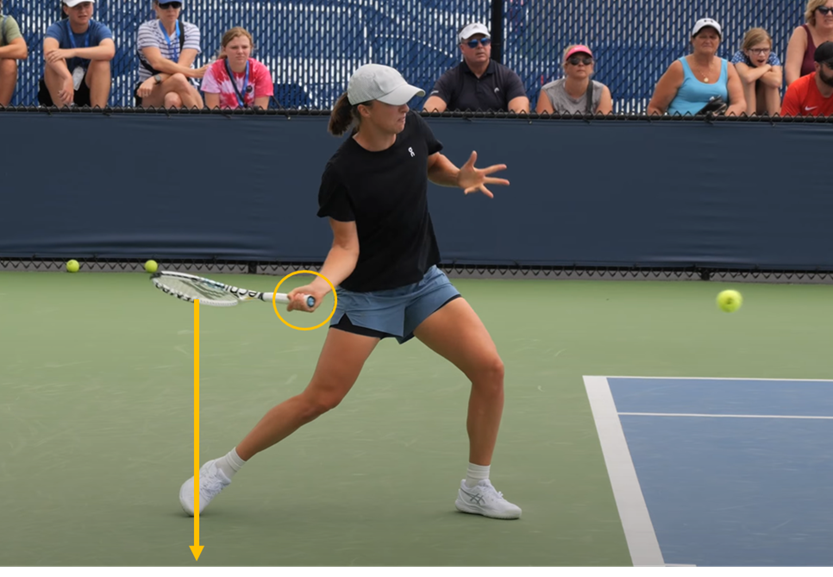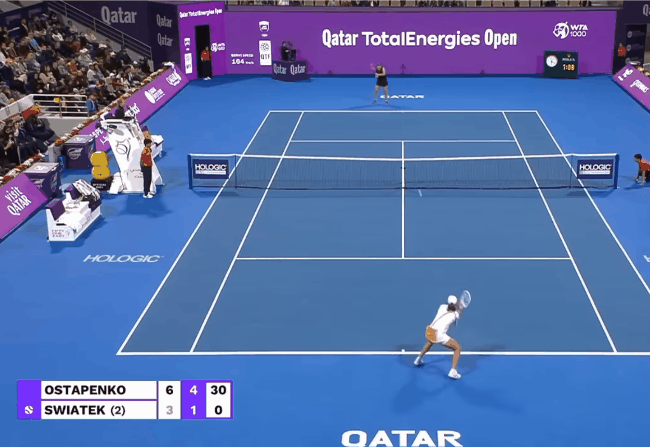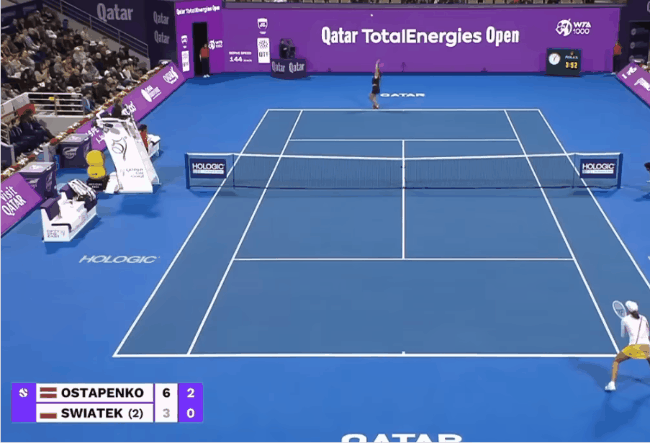Ostapenko vs Swiatek: Doha SF Analysis
Rushed forehands, hitting zones, return contrasts, reverse breadsticks
Ostapenko def. Swiatek 6-3, 6-1.
Jelena Ostapenko continued her astonishing form against Iga Swiatek on Friday night, taking down the three-time Doha defending champion in straight sets. Ostapenko extended her head-to-head record against Swiatek to an impressive 5-0, booking her place in the Doha final for the first time in 9 years.
Let’s dive into the analysis.
The effect of power hitting – rushing the Swiatek forehand
It feels like I’ve been writing a lot about the big hitters on the WTA tour in recent times – Keys, Sabalenka, and now Ostapenko.
While Keys and Sabalenka tend to exercise more control over their power, Ostapenko is a bit more kamikaze in her application; her default mode is to attack every ball. That might be a slight exaggeration, but it does mean that matches tend to be won and lost on her racquet.
Well, she got it right on Friday night. Ostapenko was able to hit through Swiatek, hitting with devastating power from both wings. Crucially, Ostapenko’s heavy hitting placed a lot of pressure on Swiatek’s groundstrokes – in particular, it rushed Swiatek’s forehand on numerous occasions.
A good example of Swiatek getting rushed on her forehand comes from early in the first set:
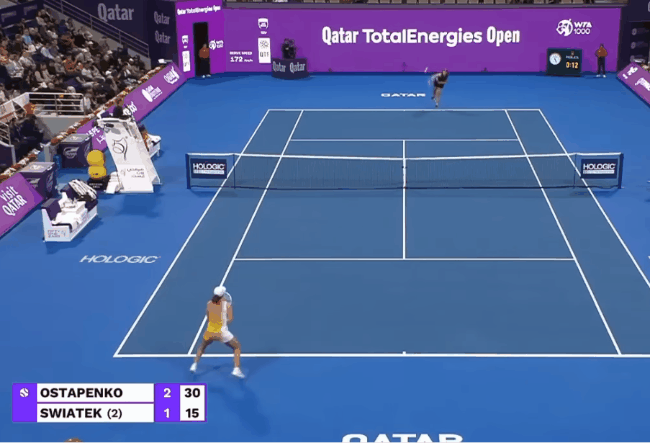
Another example from midway through the second set. The rally is once again being played through the centre of the court, but Swiatek is too late on her forehand, spooning it high and long for an unforced error:
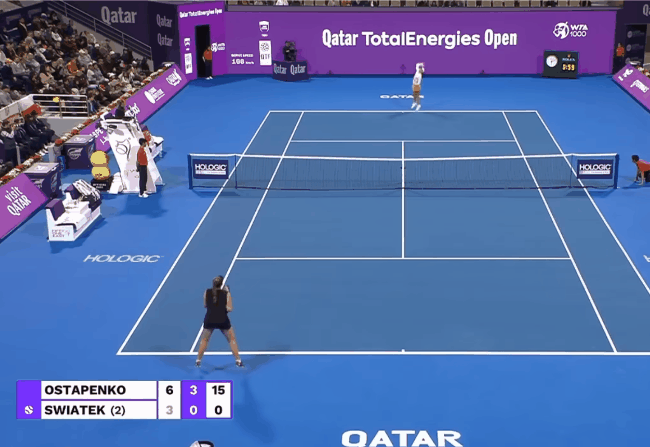
Sometimes, Ostapenko’s hitting was just simply too good. This one-two backhand combo provides a nice illustration of Ostapenko’s raw power:
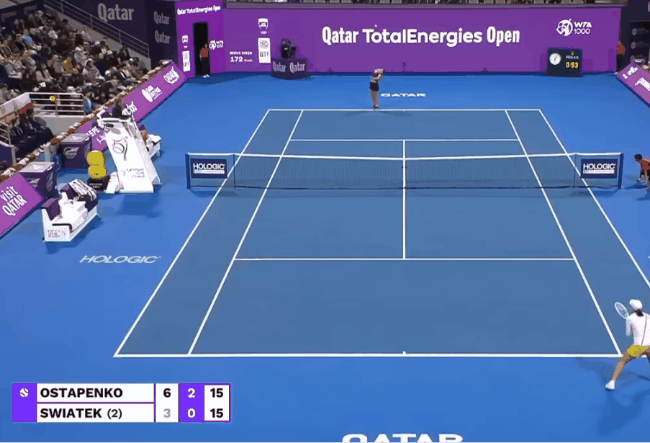
Hitting zones
That last GIF is a nice segue into hitting zones. One of the reasons that Ostapenko was able to hit so big and so consistently was due to Swiatek’s topspin-heavy forehand, which resulted in a lot of balls rising nicely into Ostapenko’s hitting arc.
Before getting into some examples from the match, here’s a quick look into the technique of the Swiatek forehand to see how that topspin is generated.
Swiatek uses an extreme western grip, where her racquet head is nearly horizontal and facing the ground as she prepares to meet the ball, with her palm facing upwards. This grip allows her to brush up underneath the ball at the contact point, generating a lot of topspin. An example below:
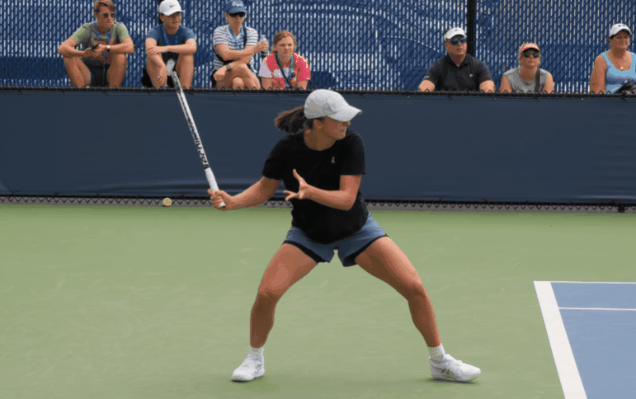
Although hitting with this additional topspin is a huge weapon for Swiatek on slower surfaces like clay, and even generally on slower hardcourts like Doha – it had a seemingly opposite effect against the big-hitting Ostapenko.
A good example of this comes from late in the second set. Although Ostapenko is sitting a bit further back on the baseline, both of Swiatek’s forehands bounce up nicely into Ostapenko’s swinging arc. This is particularly true for the first Swiatek forehand which Ostapenko seizes on, allowing her to take advantage in the rally:
Another example, this time from the first set:

Deuce court returning – Ostapenko
One of the big factors in Ostapenko’s win was her strong returning, particularly from the deuce court.
When Swiatek served down the T or to the body on the deuce side, Ostapenko won 13 of 19 points (68%). While Ostapenko’s returning was impressive, Swiatek’s serving also left something to be desired at times – many serves landed right into Ostapenko’s hitting zone.
Ostapenko’s dominance from the deuce court was immediately putting Swiatek on the back foot early in games, allowing her to put a lot of pressure on the Swiatek serve:
Take this example below from early in the second set. Swiatek puts this first serve in at 165 km/h, angling towards Ostapenko’s body. However, Ostapenko has plenty of swinging room, hitting a massive inside-in backhand. It only takes her one more shot – a swinging forehand volley – to finish the point following a defensive lob from Swiatek:
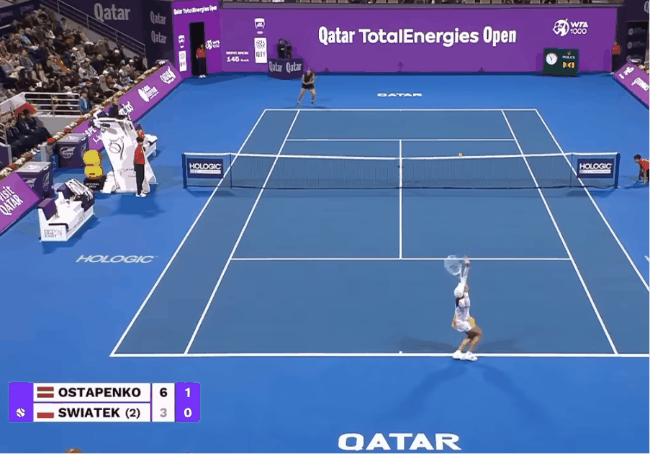
A similar example from the same game, and ending in a similar result:
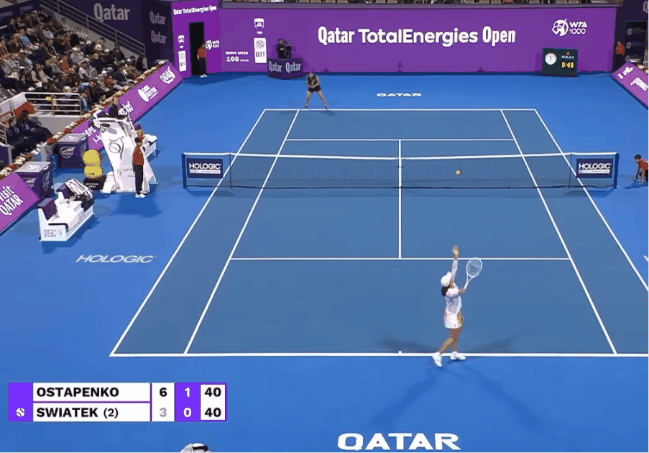
Swiatek’s return struggles
While Ostapenko had considerable success against the Swiatek serve, Swiatek struggled on her own return.
In particular, the Ostapenko slider out wide from the deuce court was a notable weakness for Swiatek - she won only 4 of 16 points (25%) against this serve:
An example here from the first set – Ostapenko hits a short-angled second serve that is sliding away from Swiatek, and Swiatek is unable to return the ball, even though her return position is already leaning towards her right side:
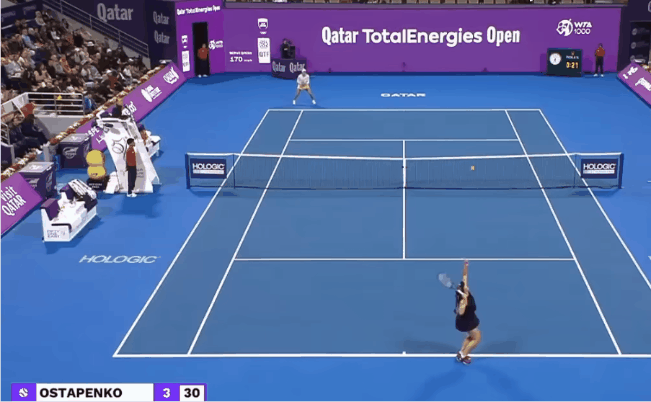
Another example here of the slider out wide from Ostapenko. Swiatek is slightly further right in her return position than in the clip immediately above, but once again, she still gets dragged out further right and coughs up the forehand error:
Short note: Reverse breadsticks and racquet throwing
Over the last 52 weeks, Iga Swiatek has delivered 23 breadsticks to her opponents (i.e., winning a set 6-1) in 75 matches.
However, on Thursday night, a rare event occurred – a reverse breadstick.1 That is, instead of Swiatek dishing out a breadstick, she was on the receiving end of one from Ostapenko in the second set. This marked only the fourth time in the last year that she has lost a set 6-1:
This stat provides a good indicator of Ostapenko’s destructive capabilities, as it’s not an easy feat to hold Swiatek to just a single game in a set. And it was this dominance by Ostapenko that took a toll on Swiatek over the match – she became visibly frustrated midway through the second, resulting in a rare racquet throw:
Overall thoughts
It’s one thing to beat Iga Swiatek, but it’s another thing to do it so comprehensively. Ostapenko was at her enigmatic best – swinging freely and powerfully, placing Swiatek under relentless pressure.
This match-up remains one of the most engrossing in all of tennis – Swiatek, who has an equal or better record against all other WTA players – is yet to find a winning solution to counter Ostapenko’s all-out aggression, and it’s been a source of frustration for Swiatek.
Ostapenko, on the other hand, remains ever-confident about facing Swiatek:
“I was pretty confident that I would obviously beat her. We played a lot of matches and I kind of know how to play against her.”
For now, Ostapenko is racing away. The impetus is on Swiatek to find a solution.
As always, thank you for reading. I hope you enjoyed.
Yes, I’ve just coined this term. Yes, it does sound a bit ridiculous (but I’m secretly hoping it sticks).





